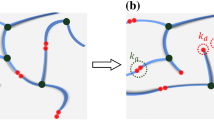Abstract
A RECENT communication by D. D. Eley and D. C. Pepper1 describes experiments on the plastic flow of plasticized cellulose derivatives. They find that the flow velocity of compression of cylinders and extension of rods depends exponentially on stress at moderate stresses as the simple relaxation theory predicts2,3, but at higher stresses flow velocity approaches linearity with stress. This behaviour at high stress leads them to question the applicability of the relaxation theory in general to flow problems.
Similar content being viewed by others
References
Eley and Pepper, Nature, 154, 52 (1944).
Eyring, J. Chem. Phys., 4, 283 (1936).
Tobolsky, Powell and Eyring, "Chemistry of Large Molecules", 125 (Interscience, 1943).
Powell, thesis, Princeton University (1943).
Blott and Samuel, Ind. Eng. Chem., 32, 68 (1940).
Goodeve and Whitfleld, Trans. Far. Soc., 34, 511 (1937).
Author information
Authors and Affiliations
Rights and permissions
About this article
Cite this article
POWELL, R., EYRING, H. Mechanisms for the Relaxation Theory of Viscosity. Nature 154, 427–428 (1944). https://doi.org/10.1038/154427a0
Issue Date:
DOI: https://doi.org/10.1038/154427a0
- Springer Nature Limited
This article is cited by
-
Two-phase analysis on radiative solar pump applications using MHD Eyring–Powell hybrid nanofluid flow with the non-Fourier heat flux model
Journal of Engineering Mathematics (2024)
-
Impact of chemical reaction on Eyring–Powell fluid flow over a thin needle with nonlinear thermal radiation
Scientific Reports (2023)
-
Heat Generation and Thermal Radiation Impacts on Flow of Magnetic Eyring–Powell Hybrid Nanofluid in a Porous Medium
Arabian Journal for Science and Engineering (2023)
-
Correction to: Swimming of Gyrotactic Microorganisms in Unsteady Flow of Eyring Powell Nanofluid with Variable Thermal Features: Some Bio-technology Applications
International Journal of Thermophysics (2023)
-
Numerical exploration of the features of thermally enhanced chemically reactive radiative Powell–Eyring nanofluid flow via Darcy medium over non-linearly stretching surface affected by a transverse magnetic field and convective boundary conditions
Applied Nanoscience (2023)




